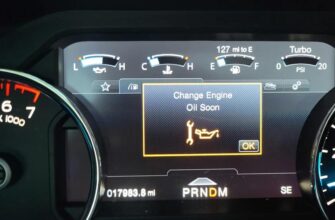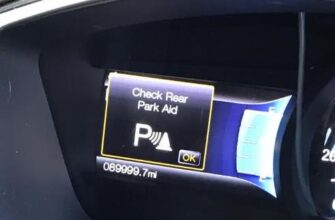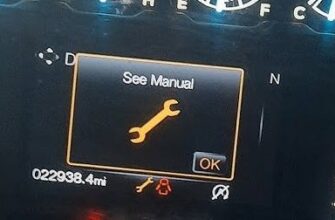You pull your powerful Ford diesel truck into a parking spot, shift into Park, and instead of the familiar low rumble of a relaxed idle, the engine RPM stays noticeably higher. It sounds like it’s working harder than it should be when just sitting still. If you’ve experienced this – your Ford diesel truck idle high in Park – you might wonder if there’s an issue brewing under the hood.
The truth is, a Ford diesel high idle in Park is often not a problem at all! Diesel engines, especially modern ones like the Power Stroke, have built-in functions that intentionally raise the idle speed in certain conditions when the truck is stationary. These aren’t glitches; they’re designed behaviors to help the engine and its complex emissions systems operate correctly.
However, there are also times when high idle could indicate an issue. Understanding the difference is key. Let’s explore the most common reasons your Ford Powerstroke high idle might kick in while you’re parked.

Normal Reasons for High Idle in Your Ford Diesel Truck (It’s Working!)
Your Ford diesel, whether it’s an F-250, F-350, or other Super Duty model, is a sophisticated piece of machinery. Several scenarios will cause the Ford truck engine RPM high in park as part of its normal operation.
1. Cold Weather Warm-Up (Intelligent High Idle)
Diesel engines are very efficient, and that means they don’t generate a lot of excess heat at a standard low idle, especially in cold weather. In freezing or near-freezing temperatures, your truck’s computer (PCM – Powertrain Control Module) might automatically increase the idle speed.
- Why it happens: This cold weather high idle Ford diesel function helps the engine reach its optimal operating temperature faster. A warmer engine is more efficient, produces fewer emissions, and, importantly, allows the cabin heater to provide warmth sooner. It also helps ensure critical components like the transmission fluid warm up.
- What to expect: The idle might jump to 900-1200 RPM or even higher depending on the specific model year and outside temperature. It should gradually decrease as the engine reaches its normal operating temperature.
“Every winter, my F-350 idles high for the first 10-15 minutes after I start it, even in Park. Totally normal. It’s just the Powerstroke warming itself up because diesels are slow to heat up at low idle.” – A seasoned Power Stroke owner
2. Diesel Particulate Filter (DPF) Regeneration
Modern diesel trucks have a DPF in the exhaust system to trap soot particles. Periodically, this filter needs to be cleaned by burning off the accumulated soot – a process called regeneration (or “regen”).
- Why it happens: Regeneration requires extremely high exhaust temperatures (over 1000°F or 500°C). If a regen cycle needs to happen, and you’re driving at low speed or idling, the truck will often increase the engine RPM (typically around 1000-1200 RPM or higher) to help generate the necessary heat in the exhaust system. This Ford diesel regen idle is crucial for keeping the emissions system functioning correctly.
- What to expect: You might notice a change in engine sound, a slightly metallic smell, increased exhaust heat (be careful where you park during regen!), and potentially a message on your dashboard indicating that the exhaust filter is cleaning. Regen can last 20-40 minutes. If you shut the truck off mid-regen, it may attempt to complete it during the next drive cycle.
“Caught my truck idling really high in the driveway one day. Looked at the dash, and sure enough, the ‘cleaning exhaust filter’ message was on. Once the regen finished, the idle dropped back down. It’s just part of owning a modern diesel.” – An owner recognizing a regen cycle
3. PTO (Power Take-Off) Engagement or Readiness
If your Ford Super Duty is equipped with a PTO (often used for auxiliary equipment like cranes, dump beds, or generators), the system will increase the idle speed when the PTO is engaged. In some configurations, the engine might also increase idle when the PTO system is active or ready for engagement while in Park.
- Why it happens: The high idle provides the necessary engine speed to power the hydraulic pump or other equipment connected to the PTO.
- What to expect: This only applies to trucks with the PTO option. The high idle will typically be constant while the PTO is engaged.
Less Common Reasons or Potential Issues
While cold idle and regen are the most frequent causes, sometimes a high idle in Park could point to something else.
4. High Electrical Load
If you have a significant electrical load on the system (e.g., running the AC on high, using powerful aftermarket accessories, or if the batteries are low), the engine might slightly increase idle to help the alternator keep up. This usually isn’t a dramatic increase like regen or cold idle, but it can be noticeable.
5. Commanded by the PCM (Other Reasons)
The truck’s computer might temporarily command a slightly higher idle for other system checks or compensations, although this is less common as a persistent, high idle issue compared to the reasons above.
6. System Malfunctions (Less Likely to Just Cause High Idle in Park)
While rare, issues like a faulty sensor (e.g., coolant temperature sensor), a problem with the fuel injection system, or an issue within the exhaust or emissions control system (beyond just needing a regen) could potentially lead to an incorrect idle speed commanded by the PCM. However, these issues are more likely to be accompanied by a Check Engine light or other warning indicators on your dashboard.
How to Diagnose Your Ford Diesel’s High Idle in Park
So, if your Ford diesel truck idle high in park, how do you figure out why?
- Check the Temperature: Is it cold outside or is the engine still cold? If yes, it’s likely the normal cold weather high idle. Wait for the engine to warm up fully.
- Look for Regen Indicators: Is there a message on your dash about exhaust cleaning? Do you notice a different exhaust smell or increased heat from the exhaust? These are signs of DPF regen. Let the truck run until the high idle and regen indicators stop.
- Check for PTO: Does your truck have a PTO? Is it engaged or is the PTO system activated?
- Listen and Observe: How high is the RPM? Is it steady or fluctuating? Does the engine sound different?
- Look for Warning Lights: Is the Check Engine light, Wrench light, or any other indicator illuminated on your dashboard? Warning lights suggest a potential problem requiring diagnosis. Our guide on the wrench light on Ford trucks covers what that specific indicator might mean, often related to powertrain issues that could sometimes affect idle.
- Listen to Your Truck: Become familiar with the normal sounds your Ford truck makes, both while driving and at idle. Understanding typical operating noises, like the sounds discussed in our article Why Is My Ford F-150 Making a Whining Noise When Accelerating?, can help you spot unusual sounds.

If the high idle persists long after the engine is warm and no regen is occurring, or if it’s accompanied by warning lights, unusual noises, or poor performance, it’s time to investigate further.
Here’s a helpful video that visually explains some of the common reasons for high idle in Ford Super Duty trucks, including regeneration: <br/> [Embed a relevant YouTube video here, e.g., search YouTube for “Ford Powerstroke high idle explained regen cold weather”] <br/>
When to Seek Professional Help
While normal high idle for warm-up or regen is no cause for concern, contact a qualified diesel mechanic or Ford dealership if:
- The high idle is constant and doesn’t drop after the engine is warm and no regen is active.
- The high idle is accompanied by a Check Engine light or other warning indicators.
- You hear unusual noises or experience performance issues along with the high idle.
- You suspect an issue with the emissions system (DPF, EGR) or fuel injection.
- You are unsure about the cause or uncomfortable diagnosing it yourself.
A professional can use diagnostic tools to read trouble codes and perform specific tests to pinpoint the exact reason for the Ford diesel high idle troubleshooting Park scenario you’re experiencing.
If you’re using resources like FordPass to monitor your truck, and it’s having trouble connecting, resolving those issues (as discussed in Troubleshooting When Ford Pass Can’t Locate Your Vehicle) can sometimes help with remote diagnostics if a deeper issue is present.
Consulting your specific Ford Super Duty Owner’s Manual will provide details on the intelligent high idle feature, DPF regeneration, and typical operating parameters for your truck’s model year and engine. Resources like Ford truck owner forums (e.g., PowerStroke.org) are also excellent places to find discussions from other owners about high idle behavior.
Frequently Asked Questions (FAQ)
Q: Is it normal for my Ford Powerstroke to idle high in Park?
A: Yes, it is often normal. Common reasons include cold engine warm-up (intelligent high idle) and Diesel Particulate Filter (DPF) regeneration.
Q: How high is a normal high idle for a Ford diesel?
A: Normal high idle during warm-up or regen typically ranges from around 900 RPM to 1200 RPM or sometimes slightly higher, depending on the conditions and specific truck model/year.
Q: How long does the high idle last during regeneration?
A: DPF regeneration can cause the engine to idle high for 20 to 40 minutes. The high idle will stop once the regen cycle is successfully completed.
Q: Will putting my foot on the brake stop the high idle?
A: Yes, pressing the brake pedal (or sometimes shifting out of Park slightly) will typically interrupt the high idle function, both for cold weather warm-up and regeneration. However, interrupting a regen is generally not recommended as it delays the process.
Q: Can I turn off the high idle feature?
A: The automatic high idle features for warm-up and regen are built-in functions controlled by the PCM and cannot typically be permanently disabled through standard user controls. Some aftermarket modules offer selectable high idle control, but the automatic safety/emissions features remain.
Conclusion
If your Ford diesel truck is idling high in Park, don’t immediately assume the worst. In most cases, this elevated idle speed is a normal and necessary function, whether it’s helping your engine warm up efficiently in cold weather or actively cleaning the Diesel Particulate Filter through a regeneration cycle. Learn to recognize the signs of these normal operations, like checking the ambient temperature or watching for exhaust cleaning messages. However, if your truck exhibits persistent high idle without these triggers, or if warning lights appear, it’s always wise to perform basic checks and consult a professional to ensure everything is operating correctly. Understanding why your Ford diesel high idle in Park occurs helps you keep your truck running smoothly and reliably.








